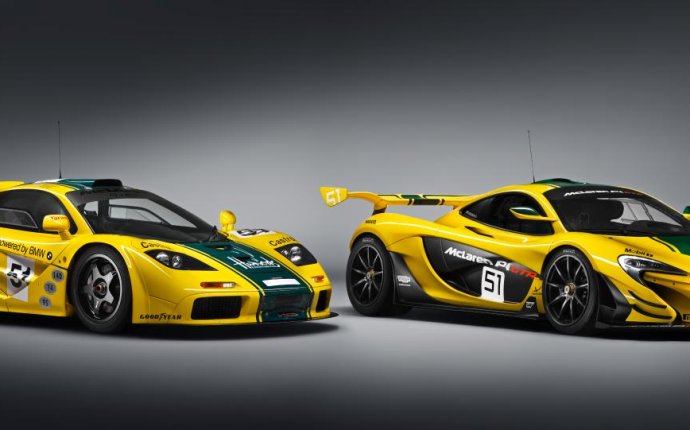
McLaren p1 Race Car
The P1 proves once and for all that even an absurdly fast car cannot make a person soil himself. Well, as far as we know.
My exposure to the P1, McLaren’s successor to the storied F1 sports car, is four laps of the Dunsfold Aerodrome in Surrey, England, a collection of airport runways and taxiways that’s perhaps better known as the track the British Top Gear television program uses. Four laps to not commit a vehicular and career embarrassment. There was a second P1 circling the track with another Dunsfold virgin behind the wheel. Oh, and the course is configured as a figure eight. Right then, no worries.
Testing confirms the P1 will sprint to 60 mph in 2.7 seconds and continue pulling hard until it reaches its governed top speed of 217 mph. But as impressive as those numbers are, they are not unprecedented in the world of supercars. Hell, a Porsche 911 Turbo S will get to 60 mph in 2.6 seconds, and McLaren’s own F1 achieved a top speed about 20 mph higher back in the ’90s. What is so remarkable about the P1, of which 375 will be made, is its ability to corral a 727-hp twin-turbo V-8, a 177-hp electric motor fed by a lithium-ion battery pack, and a mass of power electronics into a cohesive whole that manages to smoothly and easily deliver a uniquely extreme speed experience.
Do not take that to mean that the car is without drama. It is all drama. Lift off the throttle on corner turn-in and the turbo boost relieves itself with an initially shocking “woof!” You hear air howling as it’s sucked into the roof snorkel, en route to meet its fate in the eight combustion chambers. You hear the low-register rage of the engine, which, even at idle, is incomparably loud for a street car. Pebbles kicked up from the surface ping when they hit the carbon-fiber wheel wells and underside with the crack and clarity of a rifle report. Even when left in automatic mode, the seven-speed dual-clutch transmission pounds through the gears, firm and certain, a couple of milliseconds before you think about shifting.
The brake rotors, made specifically for McLaren by F1 partner Akebono, are coated with silicon carbide and have a gorgeous mirror finish, unmarred by slots or holes. Those discs are pinched by six-piston front and four-piston rear monoblock calipers and provide stellar stopping force and none of the low-speed squealing common to carbon-ceramic brakes. They are commanded by a brake pedal that is perfectly linear in operation, neither too soft nor too hard, and unsullied by any regenerative function to recharge the battery. Instead the battery is charged by the motor serving as the generator.
The steering offers no particular technical marvel. It is an electrohydraulically boosted system that is so beautifully tuned you simply don’t ever think about the steering. It feels as if it’s plugged directly into your lizard brain. That is as high a compliment as we can give.
Ensconced in the beast, you are surrounded by the expected orgy of carbon fiber (McLaren being a long-standing expert in the ways of the magic composite). It’s a serious place of business. If you are expecting something as self-consciously styled as the art-deco cabin of a Bugatti Veyron, you’ve got the wrong company. Instead, you get rotary knobs and buttons and a big digital readout in place of gauges. It has a stereo and a nav system, but you’ll forgive us for not turning them on, nor even finding their controls. The firm-but-not-constraining seats are manually adjusted. And no, there are no seat heaters. The view out the rear is by way of a carbon-fiber tunnel roughly the dimensions of a tissue box, but we weren’t looking behind us.
Not that the huge combined power output is going to be called upon frequently today. When it is, the gasoline and electric sides of the powertrain work together seamlessly, and the P1 pulls strongly and without hesitation, even with less than 2000 rpm showing on the tach. The motor fills in any gaps as the turbochargers spool, but even the top inch of the long-travel throttle pedal produces a shocking level of acceleration.
On a road like this, where the biggest gap between corners is about a quarter-mile, the idea of pushing harder seems ludicrous. Upshifting at 6000 rpm feels daring, though it’s a full 2250 rpm shy of the limiter.
As you’d expect, traction in this soggy, quintessentially British weather is an issue. Passing showers give us a chance to experience the P1 in wet, damp, and almost-dry conditions, and it’s clear that the car is predictably sensitive to moisture under its rear wheels. Even on cold tires, it finds impressive grip, but if you ask for too much (even with the powertrain switch in its safest “normal” mode and every safeguard in play), you can feel the back end squirming. In the dry and with confidence levels high, full throttle is something P1 owners will probably rarely experience on the road. We worked up the nerve to try it twice in five hours, equal to the number of extra pairs of undies we brought along.









